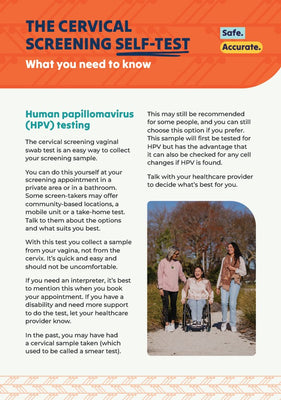Cervical screening self-test: what you need to know English HE1165

Information about the HPV cervical screening self-test option. Designed to help people decide if the test is right for them. This resource applies to cervical screening from 12 September 2023.
Please note that this is a booklet, not the test kit. Please contact a health provider to arrange a test.
The full resource:
Human papillomavirus (HPV) testing
The vaginal swab test is an easy way to collect your cervical screening sample.
You can do this yourself at your screening appointment in a private area or in a bathroom. Some screen-takers may offer community-based locations, a mobile unit or a take-home test. Talk to them about the options and what suits you best.
With this test you collect a sample from your vagina, not from the cervix. It’s quick and easy and should not be uncomfortable.
If you need an interpreter, it’s best to mention this when you book your appointment. If you have a disability and need more support to do the test, let your healthcare provider know.
In the past, you may have had a cervical sample taken (which used to be called a smear test).
This may still be recommended for some people, and you can still choose this option if you prefer. This sample will first be tested for HPV but has the advantage that it can also be checked for any cell changes if HPV is found.
Talk with your healthcare provider to decide what’s best for you.
Doing your self-test
If you chose to do a self-test you will be given a test kit with detailed instructions on what to do. If you have any questions or difficulty with the test, ask your healthcare provider for help.
Make sure your details are correct on the label and form and add anything that may be missing. You may need to fill in some information, like the date you do the test.
What if I make a mistake?
It is very easy to take your own sample and this is just as accurate as one taken by a healthcare provider.
It’s very unlikely you will get anything wrong.
It is okay to continue with the test if you:
- have touched the swab tip with your fingers (though it is best to avoid this)
- have inserted the swab into your vagina but are unsure if you have inserted it far enough.
If you drop your swab, let your healthcare provider know and ask them for a replacement.

- Wash your hands with soap and water and dry them thoroughly.
- In a private space, find a comfortable position to take your sample. You may like to sit, stand, lie down or squat. If you cannot find a position that works for you, ask your healthcare provider for help.
- Take the tube containing the swab out of the bag and remove the swab stick. You may need to hold and twist the cap to break the paper seal.
Try not to touch the swab tip either with your fingers or against any surface. - Holding the swab stick halfway down, use your free hand to open your vagina and gently insert the tip of the swab about 4-5cm (about the length of your thumb, similar to inserting a tampon).
Most people find it easy and comfortable to do. If you experience any pain, then draw the swab back a bit until it is more comfortable or ask your healthcare provider to assist. - Rotate the swab about 4 times (around 20 seconds), gently touching the sides of the vagina, then remove.
- Once you have collected your sample, check the kit instructions for next steps on what to do with the swab.
Make sure the cap on your sample is put on tightly, so it is well sealed. - Dispose of any leftover materials in the rubbish bin, then wash your hands with soap and water and dry them thoroughly.
- Place the completed sample and form back into the bag, seal it and give it back to your healthcare provider.
Next steps
If you have done your self-test somewhere other than a clinic or health centre, it should be returned as soon as you can but may be stored at room temperature until then.
Your healthcare provider will send your sample to a laboratory for HPV testing.
You will usually be contacted about your results within 1 to 2 weeks.
If your results show HPV was found (which will only be the case for around 10% of people screened) this does NOT mean you have cancer or that cancer will develop. Further checks will be recommended.
Any follow-up tests you may need will depend on what type of HPV is found. You may be recommended to have a cervical sample taken (what used to be called a smear test), to look for any cell changes, or be referred to a specialist for colposcopy, to look more closely at the cells on your cervix.
If you have a friend or whānau member who is eligible for screening. Let them know about the cervical screening self-test option.
It’s quick and easy and might just save their life!